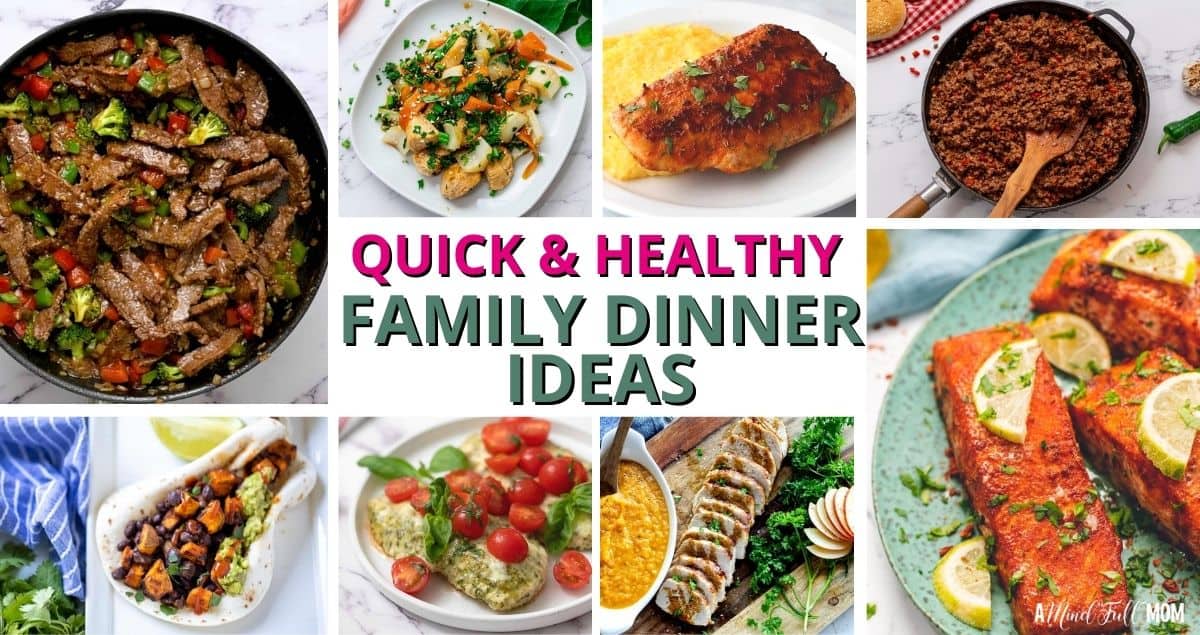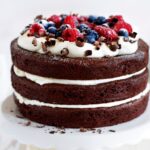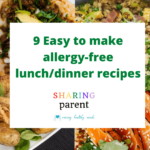Imagine a world where delicious, vibrant meals are accessible to everyone, regardless of allergies. This guide dives into the art of creating family-friendly, allergen-free dishes that are not only safe but utterly irresistible. We’ll explore simple substitutions, clever meal planning strategies, and visually stunning presentation ideas, transforming the challenge of allergen avoidance into a culinary adventure.
From adapting beloved classics to discovering exciting new recipes, we’ll equip you with the knowledge and confidence to create meals the whole family will clamor for. Learn to navigate ingredient labels, master cross-contamination prevention, and unlock the secrets to transforming ordinary ingredients into extraordinary allergen-free feasts. Prepare for a journey filled with flavorful discoveries and happy, healthy eaters!
Recipe Ideas

Creating delicious and safe meals for your family when dealing with allergies can feel challenging, but with a little creativity and the right ingredients, it’s entirely achievable. These recipes focus on vibrant flavors and simple preparation, ensuring everyone enjoys a satisfying and allergen-free meal. Remember to always double-check ingredient labels to confirm they meet your specific dietary needs.
Allergen-Free Family Favorites
Below are five family-friendly recipes that are free of the top eight allergens. These recipes utilize naturally allergen-free ingredients to create meals that are both delicious and safe.
- One-Pan Lemon Herb Roasted Chicken and Vegetables: Imagine juicy, golden-brown chicken pieces nestled amongst tender roasted vegetables, all infused with a bright, zesty lemon-herb aroma. This dish is incredibly simple to prepare. Simply toss chicken thighs and your favorite vegetables (like carrots, potatoes, and broccoli) with olive oil, lemon juice, dried herbs (rosemary, thyme), salt, and pepper. Roast at 400°F (200°C) for 40-45 minutes, or until the chicken is cooked through and the vegetables are tender. Serve hot, garnished with fresh parsley.
- Sweet Potato and Black Bean Burgers: These hearty, flavorful burgers are a fantastic alternative to traditional beef burgers. Mash cooked sweet potatoes with black beans, finely chopped onion, garlic, breadcrumbs (made from certified allergen-free bread), and spices like cumin and chili powder. Form into patties and pan-fry or bake until heated through and slightly browned. Serve on allergen-free buns with your favorite toppings.
- Coconut Curry with Chicken or Tofu: This fragrant and creamy curry is packed with flavor. Sauté onions, garlic, and ginger in coconut oil. Add your choice of protein (chicken or firm tofu), then stir in coconut milk, red curry paste, and vegetables like bell peppers, zucchini, and spinach. Simmer until the vegetables are tender and the sauce has thickened. Serve with rice (ensure it’s certified allergen-free).
- Allergen-Free Mac and Cheese: A creamy, cheesy mac and cheese that’s safe for everyone? Yes! Use a roux made from allergen-free butter and flour (such as tapioca flour or arrowroot flour), then whisk in allergen-free milk (such as oat milk or coconut milk) and a blend of nutritional yeast and cheese powder for a cheesy flavor. Stir in cooked pasta and bake until bubbly and golden brown.
- Simple Quinoa Salad: This vibrant salad is a great source of protein and fiber. Cook quinoa according to package directions. Combine with chopped cucumber, tomatoes, bell peppers, red onion, and a simple lemon vinaigrette. Add chickpeas or black beans for extra protein.
Variations of an Allergen-Free Recipe: Three Takes on Coconut Curry
The coconut curry recipe offers endless possibilities for customization. Here are three variations:
- Classic Coconut Chicken Curry: This version uses chicken as the protein source, highlighting the rich and creamy coconut milk base with warming spices. The vibrant colors of the vegetables contrast beautifully with the golden hue of the coconut milk.
- Vegan Coconut Tofu Curry: Replacing chicken with firm or extra-firm tofu creates a hearty and satisfying vegan option. The tofu absorbs the curry’s flavors beautifully, resulting in a tender and flavorful dish. The addition of toasted coconut flakes adds a delightful textural element.
- Spicy Coconut Vegetable Curry (Vegetarian): This variation focuses on a medley of colorful vegetables, such as broccoli florets, cauliflower, carrots, and peas. The addition of a touch of chili flakes elevates the heat, adding depth and complexity to the overall flavor profile. The vibrant green vegetables provide a beautiful contrast against the creamy coconut sauce.
Nutritional Comparison of Allergen-Free Main Courses
This table compares the approximate nutritional value of three different allergen-free main courses, serving as a guide for balanced meal planning. Note that exact values may vary based on specific ingredients and portion sizes.
| Dish | Calories (per serving) | Protein (grams per serving) | Fat (grams per serving) | Carbohydrates (grams per serving) |
|---|---|---|---|---|
| One-Pan Lemon Herb Roasted Chicken and Vegetables | 350 | 30 | 15 | 30 |
| Sweet Potato and Black Bean Burgers | 300 | 15 | 10 | 40 |
| Coconut Curry with Tofu | 280 | 18 | 12 | 35 |
Ingredient Substitutions & Allergen Avoidance
Creating delicious and safe allergen-free meals requires understanding suitable ingredient swaps and meticulous kitchen practices. This section details common substitutions for dairy, gluten, and soy, along with strategies to prevent cross-contamination and a guide to deciphering food labels. Careful planning and execution are key to ensuring everyone can enjoy the food, regardless of dietary restrictions.
Dairy-Free Substitutions
Dairy is a common allergen, and thankfully, many excellent alternatives exist for baking and cooking. These substitutes offer similar textures and functionalities, allowing for seamless recipe adaptation.
- For Baking: Dairy-free milk (almond, soy [if soy is not an allergen], oat, coconut) often works well in cakes, muffins, and cookies. For creaminess, consider full-fat coconut milk or cashew cream (soaked cashews blended with water). Vegan butter, made from plant-based oils, provides the richness and texture of butter. Aquafaba (chickpea brine) can surprisingly act as an egg white replacement in some recipes, adding volume and structure.
- For Cooking: Dairy-free milk is a versatile replacement in sauces, soups, and creamy dishes. Coconut cream lends a rich, tropical flavor to curries and other savory dishes. Nut-based creams (cashew, almond) create luxurious textures in pasta sauces and dips.
Gluten-Free Substitutions
Gluten, a protein found in wheat, barley, and rye, is another major allergen. Fortunately, many gluten-free flours and binders are available. Careful selection and blending often yield excellent results.
- For Baking: Gluten-free all-purpose flour blends, often combining rice flour, tapioca starch, and other flours, are widely available. Xanthan gum or guar gum are essential to mimic the elasticity of gluten, providing structure and preventing crumbly textures. Buckwheat flour, while containing no gluten, adds a unique nutty flavor and works well in pancakes or muffins.
- For Cooking: Gluten-free pasta, made from rice, corn, or other gluten-free grains, is readily accessible. Thickening sauces without gluten requires careful attention. Cornstarch or arrowroot powder are effective alternatives to wheat flour for thickening.
Soy-Free Substitutions
Soy is a common allergen and frequently found in processed foods. Finding soy-free alternatives requires careful ingredient checks.
- For Baking: Many recipes that call for soy milk can be adapted using almond milk, oat milk, or coconut milk. Tofu, a common soy-based ingredient, can be substituted with silken tofu alternatives made from other nuts or seeds, or simply omitted if it serves primarily as a binder. Soy sauce can be replaced with tamari (wheat-free) or coconut aminos.
- For Cooking: Soy sauce alternatives, as mentioned above, are crucial. Soy-based meat substitutes require careful examination of labels and may need to be replaced with other protein sources like mushrooms, lentils, or jackfruit.
Avoiding Cross-Contamination
Preventing cross-contamination is paramount when preparing allergen-free meals in a kitchen that also handles allergenic ingredients. Thorough cleaning and dedicated equipment are essential.
Imagine a vibrant kitchen, bustling with activity. To prevent cross-contamination, designate specific cutting boards, utensils, and cookware solely for allergen-free preparations. These should be clearly labeled and stored separately. After handling allergenic ingredients, meticulously clean all surfaces, utensils, and equipment with hot, soapy water. A final rinse with a sanitizing solution further reduces the risk. Consider using separate toasters and other appliances to avoid accidental contact.
Safe Food Label Reading
Understanding food labels is crucial for identifying potential allergens and ensuring a recipe is truly allergen-free. Pay close attention to the ingredient list and allergen statements.
- Examine the Ingredient List: Carefully read the ingredient list, looking for common allergens such as milk, eggs, soy, wheat, peanuts, tree nuts, fish, shellfish, and sesame. Be aware that these ingredients may be listed under various names (e.g., whey, casein for milk; malt for barley).
- Check for Allergen Statements: Manufacturers are required to clearly state the presence of major allergens. Look for statements like “Contains: Milk, Wheat” or similar declarations.
- Beware of “May Contain” Statements: “May contain” statements indicate the possibility of cross-contamination during processing. While not a guaranteed presence, it suggests a higher risk for those with severe allergies.
- Verify Ingredient Sourcing: For homemade recipes, ensure all ingredients are allergen-free. Check labels meticulously, especially for processed items.
Creative Presentation & Serving Suggestions
Transforming allergen-free meals from nutritious necessities into delightful culinary experiences hinges on creative presentation and clever serving strategies. A visually appealing dish can entice even the pickiest eater, while thoughtful serving methods elevate the entire dining experience. This section explores methods to make allergen-free food not only safe but also stunning and enjoyable.
Visually Appealing Allergen-Free Meal Presentations
Three distinct allergen-free meal presentations are detailed below, emphasizing vibrant colors, appealing textures, and enticing aromas. Each presentation focuses on a different approach to visual appeal, demonstrating the versatility of allergen-free cooking.
Presentation 1: Rainbow Veggie Skewers with Coconut-Lime Quinoa
Imagine vibrant skewers, a rainbow of color piercing the air with the sweet fragrance of grilled vegetables. Cherry tomatoes burst with juicy redness, next to sunshine-yellow bell peppers, followed by emerald green zucchini and deep orange carrots. These are threaded onto bamboo skewers, creating a visually stunning presentation. Alongside, a fluffy bed of coconut-lime quinoa, its pearly white grains speckled with green herbs and infused with the subtle tang of lime, provides a textural and aromatic counterpoint. The quinoa’s delicate fragrance blends beautifully with the smoky sweetness of the grilled vegetables, creating a harmonious and delightful sensory experience.
Presentation 2: Butternut Squash and Apple Galette with Maple-Cinnamon Glaze
Picture a rustic, golden-brown galette, its flaky crust a canvas for the vibrant hues of butternut squash and apple. The warm, earthy tones of the squash are offset by the crisp, bright red of the apple slices arranged artfully across the top. A glistening maple-cinnamon glaze, drizzled over the warm galette, adds a touch of sophisticated elegance. The aroma of warm spices and sweet fruit fills the air, promising a comforting and delicious treat. The contrasting textures—the crisp crust, the tender squash, and the juicy apples—create a delightful mouthfeel.
Presentation 3: Salmon with Roasted Asparagus and Sweet Potato Fries
Envision a plate where the deep orange of roasted sweet potato fries provides a grounding base. Atop this, a glistening fillet of salmon, its flesh a delicate pink, sits proudly. Beside it, spears of bright green asparagus, roasted to a tender crisp, add a touch of elegance. The aroma is a blend of smoky sweetness from the sweet potatoes, the rich, savory scent of the salmon, and the subtle grassy notes of the asparagus. The visual contrast between the colors and the varied textures – crispy, tender, and flaky – make this dish as visually appealing as it is delicious.
Creative Serving Ideas for Allergen-Free Meals
Creative serving methods can significantly enhance the dining experience, transforming a simple meal into a memorable occasion, especially for children. These ideas focus on making mealtime fun and engaging.
These serving suggestions aim to make allergen-free meals more appealing and enjoyable for both children and adults.
- Themed Meal Nights: Transform mealtime into an adventure with themed nights, such as “Pirate Night” with fish-shaped sandwiches or “Jungle Adventure” with vibrant fruit skewers.
- Fun Food Cutters: Use cookie cutters to create fun shapes from sandwiches, pancakes, or even vegetables, turning ordinary food into playful creations.
- DIY Stations: Set up a build-your-own bowl or taco bar, allowing everyone to customize their meal and fostering a sense of participation.
- Presentation Matters: Arrange food attractively on plates, using colorful garnishes and creative plating techniques. Even simple meals can look impressive with a little effort.
- Interactive Dining: Engage children in the preparation process, allowing them to help with age-appropriate tasks like washing vegetables or setting the table.
Creating a Visually Appealing Allergen-Free Dish: Step-by-Step Guide
This guide details the creation of the Rainbow Veggie Skewers with Coconut-Lime Quinoa, focusing on the visual aspects of the process.
Preparation:
- Wash and chop vegetables into bite-sized pieces: cherry tomatoes, bell peppers (yellow, orange, red), zucchini, and carrots.
- Cook quinoa according to package directions. Stir in shredded coconut and lime juice. Finely chop fresh herbs (cilantro or parsley) and sprinkle over the quinoa.
- Preheat grill or grill pan to medium heat.
- Thread vegetables onto bamboo skewers, alternating colors for visual appeal.
- Grill skewers for 5-7 minutes, turning occasionally, until vegetables are tender and slightly charred.
Plating:
- Place a bed of coconut-lime quinoa in the center of each plate.
- Arrange the grilled vegetable skewers artfully on top of the quinoa, ensuring a visually appealing arrangement of colors.
- Garnish with a sprinkle of extra herbs or a squeeze of lime juice for added visual interest and flavor.
Creating delicious and safe allergen-free meals for your family doesn’t have to be daunting. With careful planning, creative substitutions, and a dash of culinary ingenuity, you can craft meals that are both nourishing and delightful. This guide provides a foundation for confident cooking, allowing you to enjoy the joy of shared meals without compromise. Embrace the adventure, explore the recipes, and savor the satisfaction of creating a healthy and happy dining experience for everyone around your table.
Query Resolution
What if my child has multiple allergies?
Consult with a doctor or registered dietitian to create a personalized plan addressing all your child’s allergies. This guide provides foundational knowledge, but individual needs may require specialized guidance.
Can I freeze allergen-free meals?
Absolutely! Many allergen-free meals freeze well. Consider portioning them into freezer-safe containers for easy weeknight meals.
Where can I find allergen-free ingredients?
Most major grocery stores now carry allergen-free products. You can also find specialized options online or at health food stores.
How long do allergen-free meals last in the refrigerator?
This varies depending on the recipe. Generally, aim to consume within 3-4 days for optimal freshness and safety. Always follow proper food storage guidelines.


